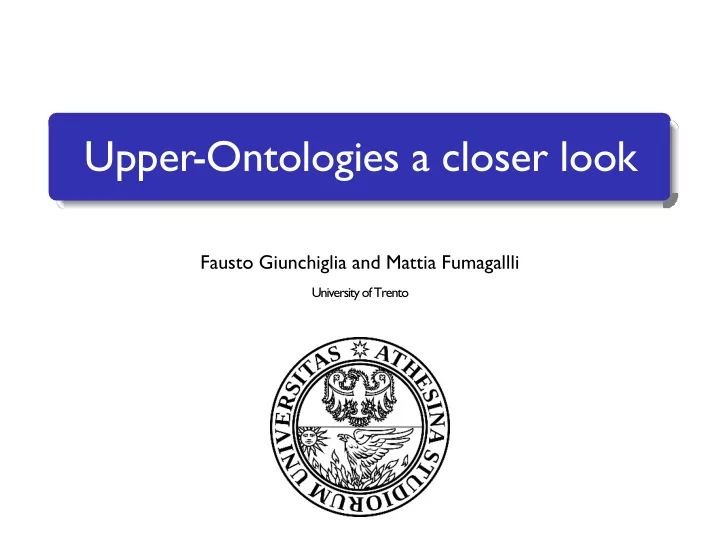

Upper-Ontologies a closer look Fausto Giunchiglia and Mattia Fumagallli University of Trento
Outline
Why not start from scratch?
Build your ontology faster
Build a better ontology
Enhanced Clarity
Improved accuracy
Reduced complexity
What to look for in a Upper Ontology
Ontological Commitment
Tradeoffs: Academic vs. Industry
Available Resources
Linguistic resources
WordNet (see next class)
Domain Specific Narrow Scope Ontologies
Dublin core
Good relations
Broadly Reusable Ontologies
Upper ontologies
Cyc and OpenCyc
Cyc and OpenCyc
Cyc: Industrial Relevance
UMBEL
SUMO
Sumo
SUMO: Industrial relevance
DBPedia/Yago
DBPedia
DBPedia: Industrial Relevance
DBPedia: Industrial Relevance
Schema.org
Schema.org
Schema.org: Focus on Usability
Schema.org: Community Effeort
Schema.org: Recent Work
Schema.org: Lesson learned
Schema.org: Process
Schema.org: Versioning
Schema.org vs Google Knowledge Graph?
Schema.org is an Upper Ontology
DOLCE
DOLCE: Fundamentals
DOLCE: Core Restriction
DOLCE
BFO (Basic Formal Ontology)
Roots and History of BFO
Principal features of BFO
BFO and DOLCE share common philosophical roots
BFO: TOP Level Class Hierarchy
Users of BFO (Consortia)
BFO (Summary)
What kind of top-level ontology?
Expressivity and Inference
Understandability
Understandability
Question for Discussion
Acknowledgments These slides have been inspired by (or reuse) (possibly adapted) content included in the following material: “Upper Ontologies a brief tour of what is available by Michael Uschold (www.semanticarts.com)”
Recommend
More recommend